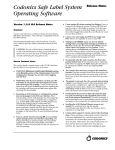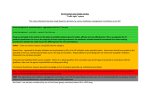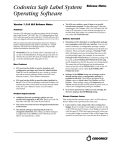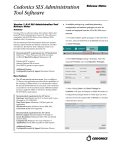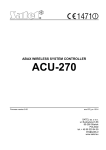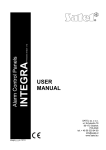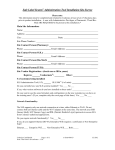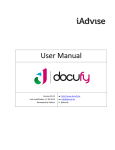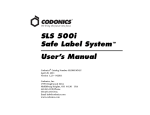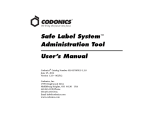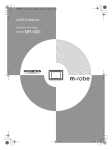Download Release Notes
Transcript
Codonics Safe Label System Operating Software Release Notes Version 1.2.2 SLS Release Notes Known Common Issues Summary This section details common issues with 1.2.2 SLS software that are likely to be experienced by most users. Version 1.2.2 software is a software release for the Codonics Safe Label System™ SLS 500i. The 1.2.2 Administration Tool (AT) software must be used with the 1.2.2 SLS software. SLS does not support software downgrades to 1.2.0 or 1.2.1. ◆ WARNING: Maximum Invalid Login Attempts setting in the Security section of the AT Configuration Manager has no effect when logging into the SLS. ◆ WARNING: The SLS user interface can lock up if the Ink button is not pressed after moving the ink carrier and loading/replacing an ink cartridge. A user should always open the front cover and press the Ink button before replacing the ink cartridge and then press the Ink button again after replacing the ink cartridge. ◆ WARNING: If an SLS is powered on without an ink cartridge, the SLS does not display the Ink Missing dialog. The SLS will print a blank Test Print or other blank labels due to the missing ink cartridge. A user should always load an ink cartridge properly. ◆ WARNING: The SLS tracking database and audit log do not fully report combination drug information. When a combination drug (e.g., BupivacaineEpinephrine) is printed, the label prints fine. However, the second drug (e.g., Epinephrine) is not recorded in the tracking database or audit logs. ◆ WARNING: Removing a USB drive too quickly (e.g., removing the USB when the green LED flashes 3-4 times) can cause the dash board message to become stuck. The system will have the message UPDATE FOUND permanently on the system. A user should wait to remove the USB until they have selected a specific update package and then clicked OK. If you want to cancel the update, wait until the select update user interface is displayed. If the message does remain, you can reboot the system to clear the message. ◆ Barcode symbology options displayed in the Administration Tool are not supported on the SLS. These are EAN-13, Code 39 and Code 32. If required contact Codonics technical support. ◆ Install package dialogs can stack up on the SLS user interface. If a user inserts one USB drive with a new update package right after another was inserted and removed without selecting a package to be installed, a new install package dialog box will appear. This document provides information about new features, product improvements and defects corrected in 1.2.2 SLS software. The SLS User’s Manual provides further information about the SLS. WARNING: The use of label colors is intended only as an aid in the identification of drug groups and does not absolve the user from the duty of reading the label and correctly identifying the drug prior to use. Product Improvements ◆ Additional barcode symbology options are now enabled on the SLS. These are Interleaved 2 of 5, IFT-14, UPC-E, UPC-E1, and EAN-8. Defects Corrected ◆ ◆ If 0 is entered for expiration time, the label now prints with a standard "Expires: ____________" with nothing entered. This alerts a user to fill it in with a correct expiration date manually or tell their administrator to change the formulary. Improved the default settings of the label position. The printed label position is now more centered on the label stock and should require less adjustment when installing software or a new configuration package. ◆ ◆ ◆ Renaming an SLS formulary or configuration package does not propagate to the SLS user interface. When downloading a newly built package, the AT prompts the user to save the package. A default name is suggested (e.g., SLS-FORMULARY-DEFAULT-0003.pkg) but you can save the package with a custom name (e.g., MYFORMULARYREPORT.pkg). When the customnamed package is loaded onto SLS, the SLS does not list the custom name in the prompt identifying valid packages on the SmartDrive. It uses the default package name. There is a delay between pressing OK on a successful update dialog and the user interface responding. The dialog indicating an update package was successfully applied does not dismiss immediately when OK is touched. It takes several seconds for the user interface to clear the message. Users need to create unique IDs when creating User Badges. If user A creates a User Badge on system A with an ID 12345 and user B creates a User Badge on system B with the same ID 12345 (and same password), when user A scans their badge on system B, they will be logged into system B as user B and vice versa for user B on system A. ◆ There is no capability to recover your PIN. Create a new user badge and PIN if you forget your PIN. ◆ Settings in the Utilities screen are reset to default settings when a configuration package is installed on the SLS. The SLS has the option in the Utilities screen to Adjust Label Print Position and Cut Position. These settings along with Brightness and Volume remain set after an SLS restart or power cycle, but are reset to defaults when a new configuration package is installed. This requires you to reset the label and cutter position every time a configuration package is loaded. ◆ Occasionally after the unit is inactive, the first label printed will be faint. If this situation occurs, reprint the label either by pressing Try Again during the test print or by opening the Utilities screen and pressing Clean Nozzle. ◆ The printer is not ready for a few seconds after printing a label. If you attempt to print a label immediately after the last print is complete (i.e., right after the cutter is engaged), the system puts a dialog error Printer is not responding or has an error. If you wait a couple seconds more, the system will not present this popup. ◆ Printed labels do not always fully eject into the drop tray and can build up in non-sequential order in the tray if not removed immediately. For safety purposes, a user should make sure to immediately remove each label and apply it to the syringe after it is printed and confirmed. ◆ Custom labels appear to remain selected after touching them. When selecting a custom label to print on the SLS, it becomes highlighted (i.e., selected) upon touch. Sometimes, the custom label remains highlighted but does not print. Other times, the custom label prints and then after the print view label clears from the user interface, the custom label becomes highlighted again. ◆ Certain buttons take a long period to acknowledge that the button has been pressed. For example, the Manage Features button in the Utilities screen and the OK button from the Add Feature Key screen. ◆ Custom Label text does not make Japanese characters bold like it does English letters. ◆ Printer error dialogs are inconsistent depending on system state. The error dialogs are slightly different if the system detects the error while idle versus when the system is printing. ◆ Languages that are written right-to-left (e.g., Hebrew, Arabic) are improperly formatted on the SLS user interface during verification. If a user creates a formulary in the en-US-1 locale on the AT and uses rightto-left languages for the drug name, when performing verification on the SLS, the drug name will be shown between the concentration and the units. ◆ Languages that are written right-to-left (e.g., Hebrew, Arabic) place the colon on the wrong side of the label tags. The separator (i.e., colon) between the label tag (e.g., Prepared, Expires, By) and the text for those fields is placed on the left side of the tags instead of the right. ◆ Languages that are written right-to-left (e.g., Hebrew, Arabic) place the By, as in “Prepared By”, tag on the right of the text field value for the user initials instead of the left. ◆ Text can be selected and highlighted on the SLS display screen. Occasionally if you touch part of the words on a screen they will become highlighted. Touch a different part of the screen away from what is highlighted to clear the highlight. ◆ Truncated user interface message. The "Label Failed Confirmation" message is truncated. It is displayed as "Label Failed Confirmat...". ◆ A Drug Failed Verification warning message persists through a software install. To clear the message, select Clear errors from the Utilities screen or install a new formulary. ◆ The Load button does not always consistently present the correct number of labels. If you press the button once and close the front cover, it will present and cut a label. If you press the Load button more than once the number of labels presented and cut can vary from the number pressed. ◆ The scanner does not always recognize the container’s barcode. Place the container closer to the front cover with the barcode facing inwards toward the neck of the SLS. Make sure to have the scanner cross-hairs line up on the barcode. ◆ Scanning a barcode while the SLS information screen is displayed will lead to a critical application error. This situation occurs when an SLS has a configuration of factory default settings and no formulary loaded. ◆ A scanned vial is acknowledged (i.e., beeps) but does not print a label while a user is opening or closing the Utilities panel. The SLS will print a label if the Utilities panel is fully open or fully closed. ◆ The printer stops working if the door is opened when the cutter is about to engage. If a user opens the front cover right at the moment that the cutter would normally engage, the system does not cut. The printer then enters a failure state where the next label printed fails along with all subsequent prints. Instead of printingthe next label, the cutter actually immediately engages and the media is unwound. To correct the issue, power cycle the unit and manually reload the media. ◆ The Custom Labels (e.g., Blank, Lines, IV, Patient) text on the SLS is truncated in the center of the name if it’s too long of a name. Use the AT Configuration Manager to change the name. ◆ The Drug Not Found Mode Switch functions incorrectly on the SLS if custom tabs are rearranged in the AT and deployed to the SLS via a configuration package. The Custom Labels section of the AT allows the custom tabs (e.g., BLANK, LINES, IV, PATIENT) to be rearranged in the order they are displayed on the SLS touch screen. At the same time, the System section of the AT allows the Drug Not Found Mode Switch to select which tab will be opened when the user scans a drug and the drug is not found. On SLS, for example, if the Drug Not Found Mode Switch is set to BLANK and a drug not found occurs, the BLANK tab will open. However, if a user creates a configuration package on the AT and deploys it to the SLS where the BLANK tab has been rearranged from its original tab position, a drug not found condition will cause a different tab to open. ◆ After choosing to not Shut Down or Restart, scanning a drug vial causes a Choose an Option error dialog instead of initiating printing of a syringe label. If you still need to scan vials and print labels when in the shutdown screen, press Cancel and scan the vial. ◆ If a drug vial is scanned on the SLS and the system cannot find the audio file requested, an error message will appear stating that the database may have been compromised. If this occurs, contact your System Administrator to review the formulary or contact Codonics Technical Support. Known Uncommon Issues This section details uncommon issues with 1.2.2 SLS software that are unlikely to be experienced by most users. ◆ WARNING: Spoken voice messages and scanner beeps do not play after the software has started-up or sometimes stop playing during operation. If this occurs, restart the system and the spoken messages will begin again. ◆ WARNING: If the first drug in the formulary is corrupted, the SLS will not open up the Utilities screen to diagnose the problem. Contact Codonics Technical Support to correct the issue. ◆ WARNING: A warning message (e.g., WARNING: This is a Paralyzing Agent) that is too long in the formulary might cause the message to be truncated on a label. The label field will be truncated and ellipses will be used to show the truncation. The user should revise the warning message to prevent the truncation. ◆ The SLS cannot be shut down from the user interface if the ink is removed. An error message will occur indicating ink is out preventing the user from shutting down the SLS. ◆ You need to be logged into the SLS to shut down the SLS. ◆ The auto-logout timer doesn't start while Available Updates is displayed. If a USB flash drive is inserted in the side of the SLS and the Available Updates screen is shown, then the SLS will not auto-logout a user. Removing the USB flash drive will auto-logout a user. ◆ Loading a specific configuration package on the SLS can create a critical application error. If a configuration package is created with a section (e.g., Blank Label) that has 0 labels and is then loaded on the SLS, a critical application error will occur on startup of the SLS ◆ A User Badge is not recognized after the SLS times-out. If the SLS times-out while performing a pre-print confirmation, when logging back in with your user badge, the system may not log you in and you will need to manually enter your ID and PIN. ◆ Applying updates to an SLS does not clear an Out of Service state. Powering off a unit while performing an update and then powering the system back on will cause an Out of Service state. Performing the update will not clear the Out of Service. If this issue occurs, contact Codonics to clear the error. ◆ A System Busy popup does not always appear. When pressing a tab (e.g. LINES) while printing, the System Busy popup does not always display, but you cannot perform an action. If you press the tab two or three times in rapid succession, it may display a System Busy popup. ◆ When you run out of labels, the modal dialog box prevents you from completing a post-print confirmation scan. You need to replace the labels and then complete the post-print confirmation. ◆ On rare occasions, a SmartDrive is Corrupt message is displayed on the user interface after a power cycle. The system will go Out of Service. Contact Codonics Technical Support. ◆ A No Scanner message and yellow LED warning state is briefly displayed when changing an ink cartridge. The state may persist for two to three seconds, and then the system returns to a green LED and Ready state. ◆ The SLS will cut labels prematurely when power to the SLS is toggled too fast. When recycling power to the SLS too quickly, the SLS will discharge labels and cut the label roll between the third label which can cause damage to the cutter. When cycling power to an SLS, wait ten seconds before powering the SLS back on. ◆ Low Ink dialog warning not displayed. Installing a new ink cartridge after a low ink situation and never restarting the system will cause the Low Ink warning to not display the next time the system returns to a low ink condition. A user should restart the SLS so it will cause the Low Ink Warning dialog message to display the next time an ink cartridge is low. ◆ If the printer becomes disconnected internally, the status message will be No Printer but there will be no error code dialog providing information regarding what to do. Contact Codonics Technical Support. ◆ Using the Service Login menu option to clear errors does not clear drug verification failures. Your System Administrator can clear drug verification failures from either the Utilities screen (e.g., Clear Errors) or by installing the existing or new formulary. ◆ It is possible for the system to enter a state where it cannot scan back a label during post-print confirmation. If a user opens the cover while printing a label and then closes the door after the label is done printing, the system may not scan the barcode during post-print confirmation. Follow the instructions on the SLS display for Unable to Scan. ◆ SLS does not print after recovery from an ink carriage stall error. If this occurs, shutdown and restart the SLS. ◆ Incorrect error dialog is displayed for a failed touch screen calibration. The message displayed may tell you to consult the User’s Manual or Technical Brief. Instead, re-run the calibration utility. ◆ The label position is not able to be reset from the SLS user interface. If an SLS has the label position adjusted to the most negative positions (i.e., -30 and -30 for horizontal and vertical position), and the SLS software is upgraded without changing the settings back to 0 and 0, the new horizontal default setting will be set below the minimum position to -55. The position cannot be changed using the user interface (i.e. the increase/decrease horizontal position buttons are disabled). Adding a configuration or formulary package to the SLS will update the settings and allow a user to reset the positions using the SLS user interface. Technical Support If problems occur during software installation or operation, contact Codonics Technical Support at any time. Phone: Email: Website: +1 (440) 243-1198 [email protected] www.codonics.com Get it all with just one call 1.800.444.1198 All registered and unregistered trademarks are the property of their respective owners. Specifications subject to change without notice. Copyright © 2010–2011 Codonics, Inc. Printed in the U.S.A. Part No. 901-243.005.05 17991 Englewood Drive Cleveland, OH 44130 USA +1 (440) 243-1198 +1 (440) 243-1334 Fax Email [email protected] www.codonics.com Codonics Limited KK New Shibaura Bldg. F1 1-3-11, Shibaura Minato-ku, Tokyo, 105-0023 JAPAN Phone: 81-3-5730-2297 Fax: 81-3-5730-2295





